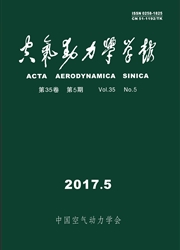

 中文摘要:
中文摘要:
综合比较了现有的非平衡热环境工程计算方法,发现采用不同方法给出的计算结果相互之间差别较大。本文基于边界层中的原子复合反应主要发生在靠近壁面薄层内的特点,将边界层中的气相反应等价到表面上,建立了同时考虑边界层内非平衡反应和表面催化特性的非平衡边界层气动加热工程计算新方法。计算结果表明,非平衡效应主要集中在飞行器头部区域,下游边界层热流逐渐趋于平衡值。本文工程方法计算结果与有关飞行测量结果吻合较好。
 英文摘要:
英文摘要:
A detailed description of the methods used to evaluate the non-equilibrium and catalytic surface effects on thermal environment of the reentry vehicles is presented.There are lots of engineering prediction models for non-equilibrium effects since 1950s,most of them based on the hypothesis that the boundary layer is frozen and recombination of the dissociated gases only occurs at the wall surface depending on the wall catalytic properties.Five widely used meth-ods for one same question are selected and compared,and their results are quite different from one another.Based on recently numerical results and theoretical analysis,a new model which takes chemical reactions both in boundary layer and on body surface into account simultaneously is proposed in this paper.It is shown that the chemical state of the boundary layer is controlled mainly by the recombination that takes place near the wall,which suggests representing the gas-phase reaction by an equivalent surface reaction with all state variables specified by surface conditions.The equivalent surface reaction method then can be extended to the case in which the surface has an arbitrary catalytic.The results obtained by this proposed model agree quite well with the flying test data of STS-2 space shuttle.From the calculation results,the non-equilibri-um effect often appears when the vehicle flight altitude is above 50 km at atmosphere accompa-nied by the rarefied flow effects,and the non-equilibrium effect mainly occurs near the nosetip regions.At the place far down the nosetip,the chemical state of the boundary layer will transfer to equilibrium.
 同期刊论文项目
同期刊论文项目
 同项目期刊论文
同项目期刊论文
 期刊信息
期刊信息
